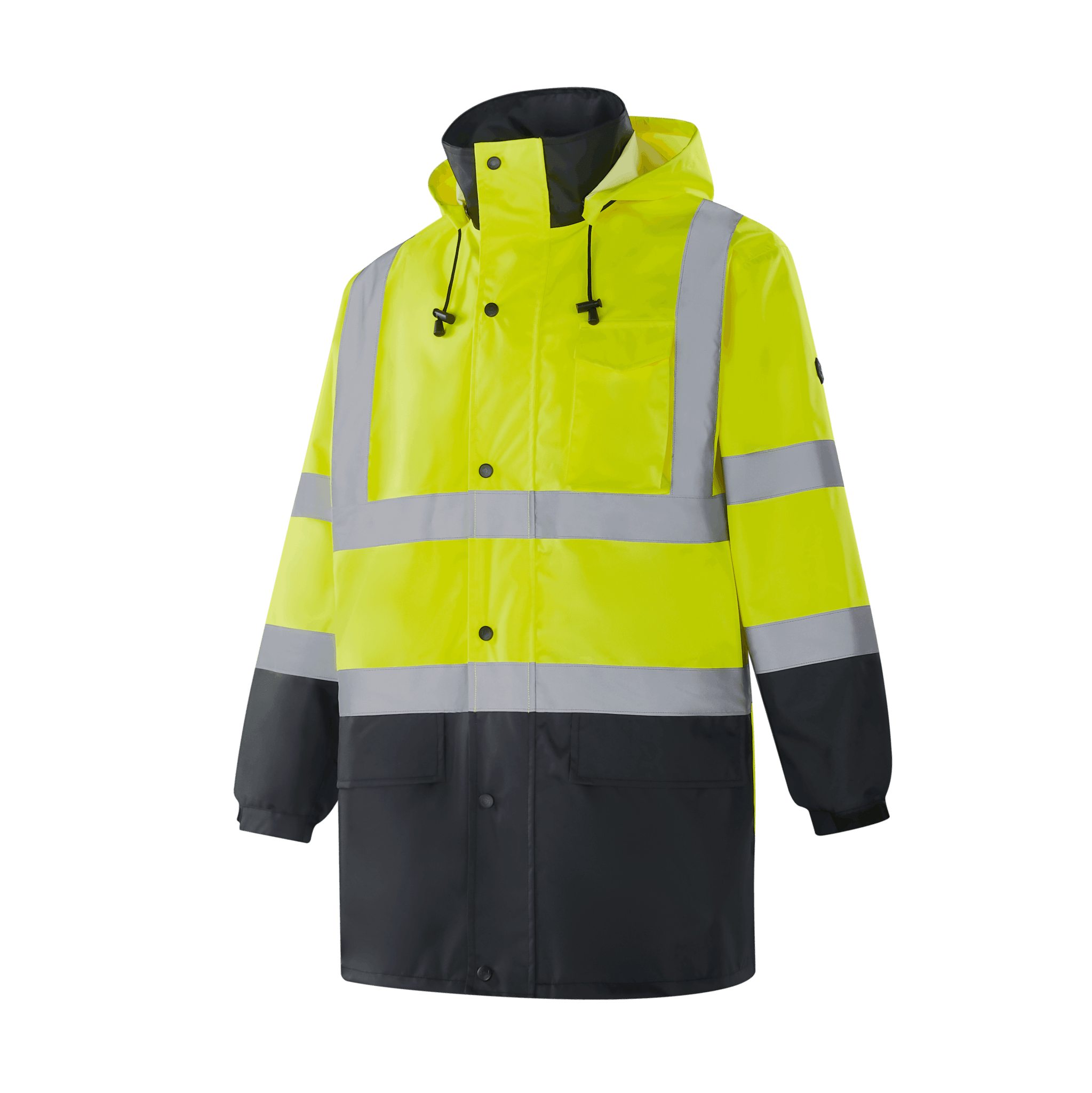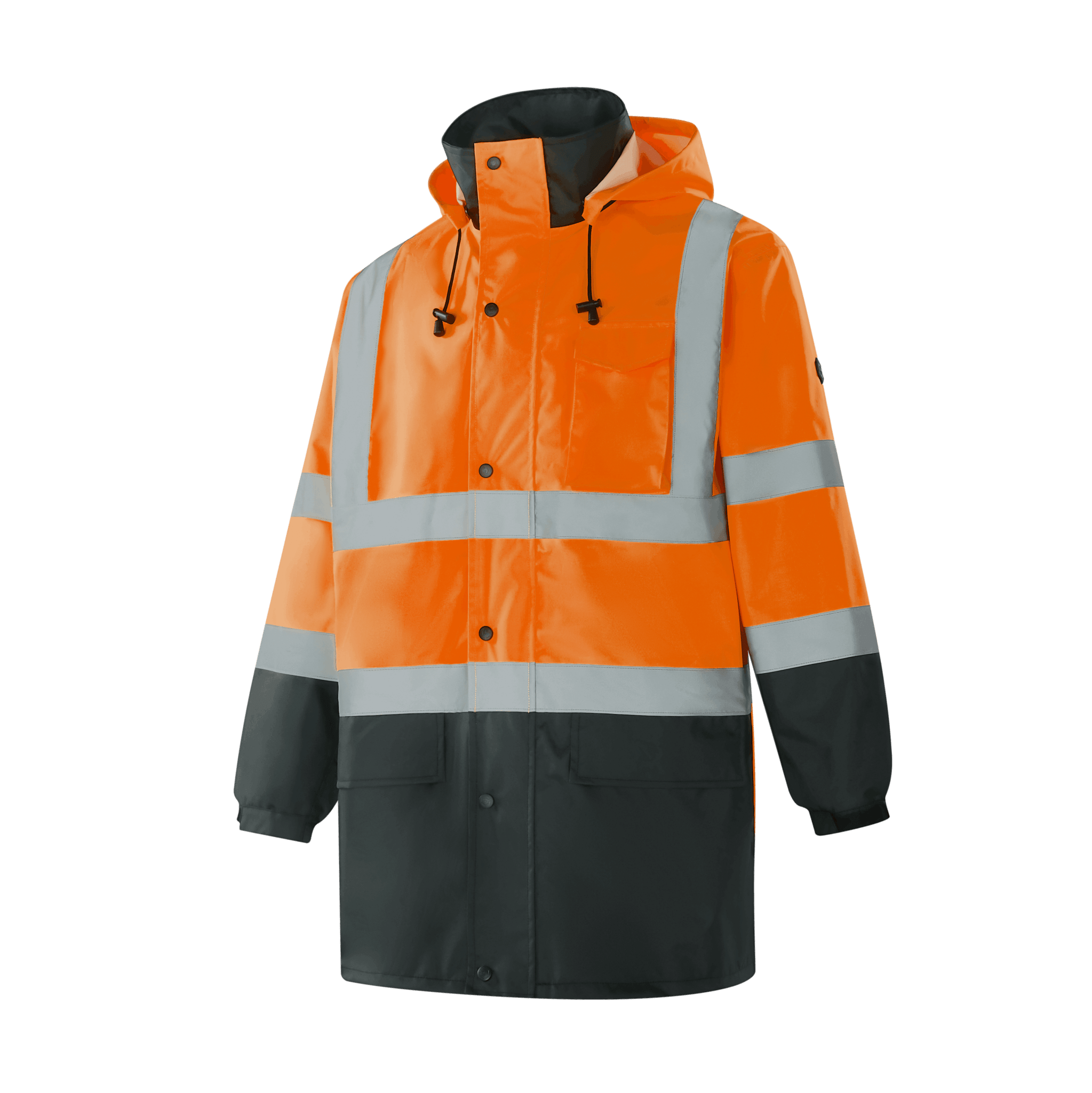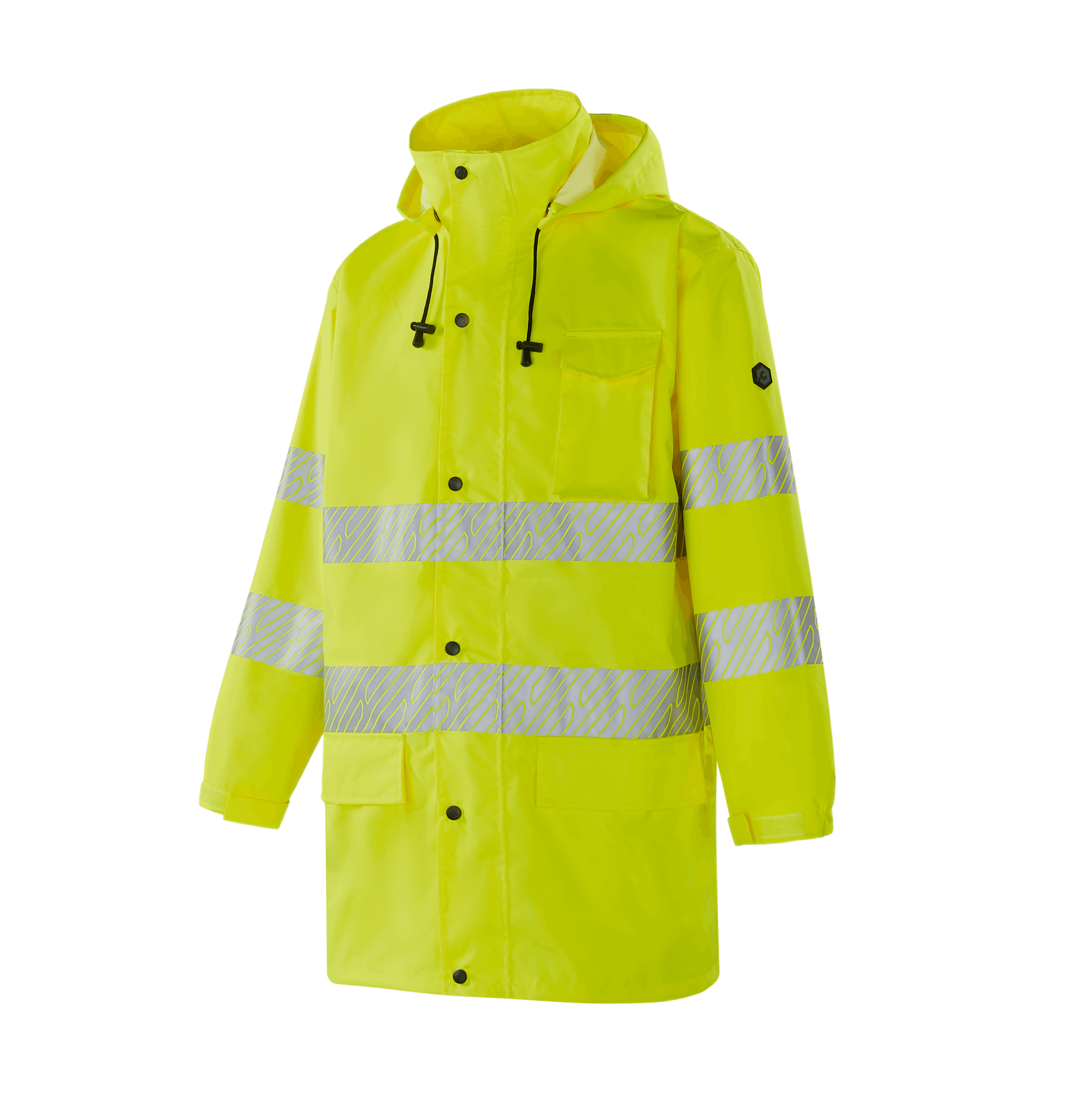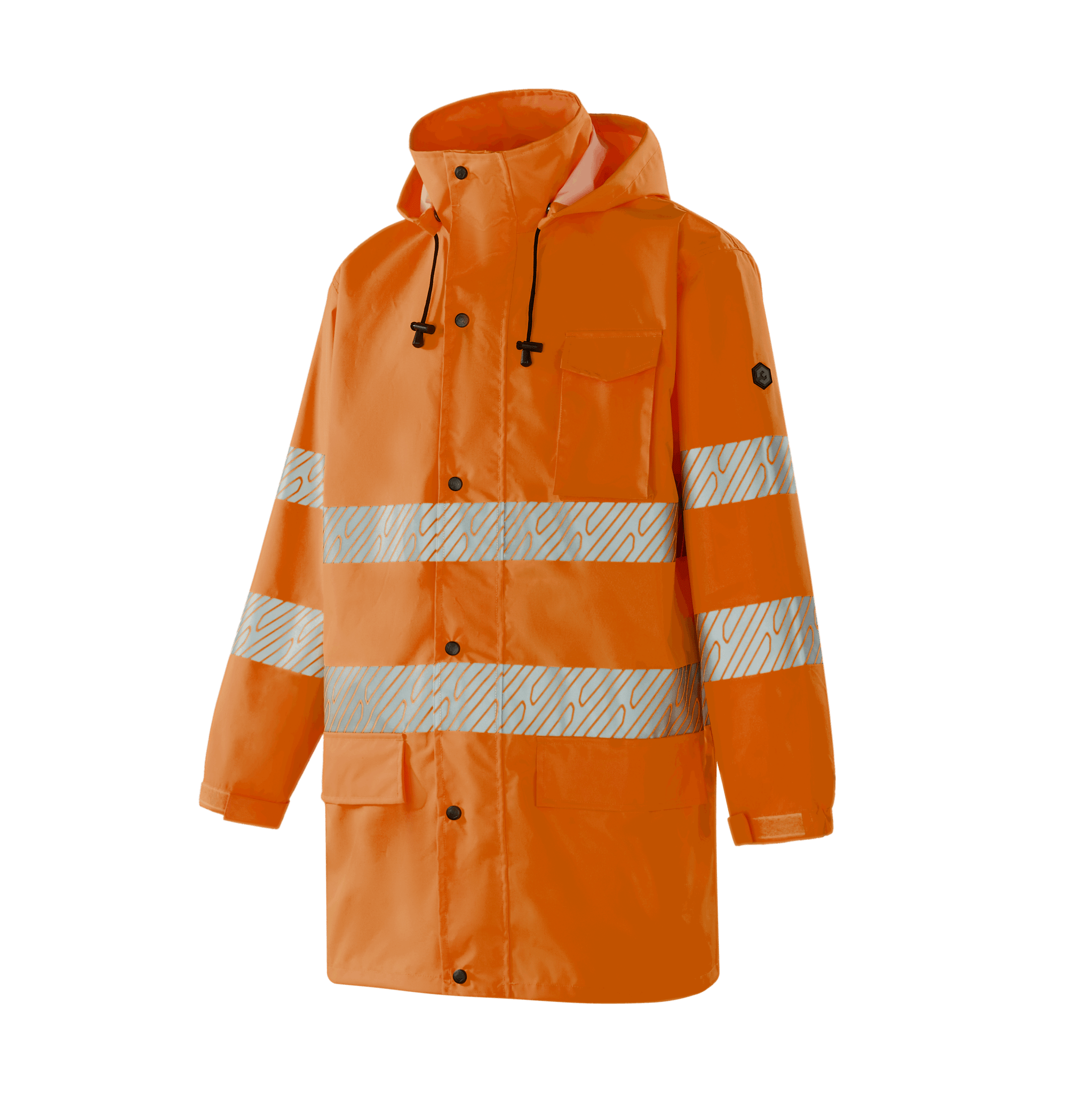
Etwas, das Sie wissen müssen: Warum Farben und Sichtbarkeit bei Arbeitskleidung wichtig sind
Dieser umfassende Leitfaden erläutert die wissenschaftlichen Grundlagen und Normen für Warnfarben und Reflexstreifen in europäischer Arbeitskleidung. Von der Einhaltung der EN ISO 20471 über Materialarten bis hin zu Pflegetipps – erfahren Sie, wie Sie Schutzkleidung auswählen, die wirklich schützt.
01 July 2025
Aktie
Inhaltsverzeichnis
- Was ist Hi-Vis-Material?
- Reflektierendes Klebeband und Warnschutzband: Eine Erläuterung der Terminologie
- Arten von reflektierendem Klebeband in europäischer Arbeitskleidung
- Hi-Vis-Farben in Europa verstehen
- Europäische Norm EN ISO 20471: Was sie bedeutet
- Auswahl der richtigen Warnkleidung für europäische Arbeitsplätze
- Pflege und Wartung von Warnschutzkleidung
- Die Rolle der Farbpsychologie und der Sichtbarkeit von Arbeitnehmern
- Nachhaltige Warnschutzkleidung: Ein wachsender Trend in Europa
- Fazit: Sichtbarkeit ist eine Sicherheitsnorm, keine Option.
- Über WERKVIS
In gefährlichen Arbeitsumgebungen beginnt Sicherheit mit guter Sichtbarkeit. Ob auf Baustellen, Verkehrsknotenpunkten oder in Industriegebieten – Arbeiter sind täglich Risiken ausgesetzt, die sich durch geeignete Warnkleidung deutlich reduzieren lassen. Zwei wesentliche Elemente sind dabei entscheidend: reflektierendes Band (auch als Warnschutzband bekannt) und gut sichtbare Farben.
Dieser umfassende Leitfaden untersucht die Funktion und den Nutzen von gut sichtbaren Materialien, erklärt die Funktionsweise von reflektierendem Klebeband und erläutert, wie gut sichtbare Farben eine entscheidende Rolle für die Sicherheit und die Einhaltung von Vorschriften am Arbeitsplatz spielen.

Was ist Hi-Vis-Material?
Warnschutzmaterial bezeichnet speziell entwickelte Stoffe, die die Sichtbarkeit des Trägers erhöhen. Typischerweise kombiniert es eine fluoreszierende Grundfarbe mit reflektierendem Band, um die Sichtbarkeit bei unterschiedlichen Lichtverhältnissen zu gewährleisten, darunter Tageslicht, Dämmerung und Dunkelheit.
Zu den wichtigsten Eigenschaften von Warnschutzmaterialien gehören:
- Fluoreszierende Färbung für die Sichtbarkeit bei Tageslicht
- Retroreflektierende Elemente wie zum Beispiel gut sichtbares Klebeband zur Erkennung bei Nacht
- Haltbarkeit um industrieller Beanspruchung und Waschen standzuhalten
- Einhaltung mit internationalen Standards wie EN ISO 20471 oder ANSI/ISEA 107
Warnschutzstoffe werden üblicherweise aus Polyester oder Polyester-Baumwoll-Mischgewebe hergestellt, wobei zur Erhöhung des Tragekomforts manchmal auch Netzgewebe oder feuchtigkeitsableitende Technologien eingesetzt werden.
Reflektierendes Klebeband und Warnschutzband: Eine Erläuterung der Terminologie
Reflektierendes Band Und gut sichtbares Klebeband sind austauschbare Begriffe, die dasselbe Bauteil beschreiben: einen Materialstreifen, der Licht zu seiner Quelle zurückreflektiert, typischerweise von Fahrzeugscheinwerfern oder Arbeitsplatzbeleuchtung.
Reflektierendes Klebeband ist unerlässlich, um bei schlechten Lichtverhältnissen oder in der Nacht gut sichtbar zu sein. Es sendet kein Licht aus, sondern reflektiert es durch Retroreflexion direkt zur Lichtquelle zurück. Dadurch wirkt der Träger auch in fast völliger Dunkelheit schon von Weitem beleuchtet.

Arten von reflektierendem Klebeband für Arbeitskleidung
Die Art des in einem Kleidungsstück verwendeten Reflexbandes kann dessen Leistung, Tragekomfort und Lebensdauer beeinflussen. Zu den Hauptkategorien gehören:
1. Aufgenähtes Reflexband
- Fest auf den Stoff genäht
- Extrem langlebig und geeignet für industrielle oder stark beanspruchte Umgebungen
- Kann die Flexibilität verringern und das Gewicht erhöhen

2. Wärmeübertragungsreflektierendes Klebeband
- Anwendung mittels Hitze und Druck
- Bietet eine glatte, leichte Oberfläche mit guter Flexibilität
- Ideal für leichtere Kleidungsstücke wie T-Shirts und Poloshirts

3. Segmentiertes Reflexband
- Besteht aus kleineren reflektierenden Segmenten, um Flexibilität und Atmungsaktivität zu erhöhen
- Wird häufig in Funktionsarbeitskleidung verwendet, bei der Bewegungsfreiheit entscheidend ist.

Jedes dieser Bänder kann je nach Art der Arbeitskleidung und deren beabsichtigter Funktion strategisch eingesetzt werden.
Hochsichtbarkeitsfarben verstehen
Reflektierendes Klebeband spielt zwar eine wichtige Rolle für die Sichtbarkeit bei Nacht, doch gut sichtbare Farben sorgen dafür, dass der Träger auch tagsüber gut erkennbar ist. Die gängigsten gut sichtbaren Farben sind fluoreszierendes Gelbgrün, Orangerot und Rot.
Diese Farben wurden basierend darauf ausgewählt, wie das menschliche Auge sie unter verschiedenen Lichtverhältnissen wahrnimmt. Fluoreszierende Materialien funktionieren, indem sie unsichtbares ultraviolettes Licht in sichtbares Licht umwandeln und dadurch die wahrgenommene Helligkeit erhöhen.
Gängige Warnschutzfarben und ihre Anwendungsbereiche:
- Fluoreszierendes GelbgrünHäufig im Verkehr, in der Logistik und im allgemeinen Bauwesen.
- Fluoreszierendes Orange-RotHäufig verwendet im Autobahn-, Schienen- und Flughafenbereich
- Fluoreszierendes RotGeeignet für Rettungsdienste und Feuerwehren
Diese gut sichtbare Farben Sie bieten maximalen Kontrast zu üblichen Hintergründen im Freien und in städtischen Umgebungen und gewährleisten so, dass die Arbeiter bei unterschiedlichen Wetter- und Lichtverhältnissen gut sichtbar sind.

Einhaltung der Sicherheitsstandards: Die wichtigsten Normen
Die Gewährleistung, dass Kleidungsstücke die Sicherheitszertifizierungen erfüllen, ist keine Option – sie ist in vielen Branchen eine gesetzliche und betriebliche Voraussetzung.
EN ISO 20471 (Europa)
- Klasse 1Minimale Sichtweite, geeignet für Bereiche mit geringem Risiko
- Klasse 2Mittleres Niveau, geeignet für viele Alltagskleidungsstücke
- Klasse 3Für maximale Sichtbarkeit ist eine Ganzkörperbedeckung mit mehreren reflektierenden Streifen erforderlich.
Wichtige Überlegungen bei der Auswahl von Warnschutzkleidung
Um die effektivste Warnkleidung für Ihr Team oder Ihren Arbeitsplatz auszuwählen, sollten Sie Folgendes beachten:
- ZertifizierungsstufeWählen Sie stets Kleidungsstücke, die der für Ihre Branche und Ihren Standort erforderlichen Klasse oder Art entsprechen.
- Klebebandplatzierung: Stellen Sie sicher, dass reflektierendes Klebeband um Oberkörper, Arme und Beine angebracht ist, um eine 360-Grad-Sichtbarkeit zu gewährleisten.
- MaterialqualitätAchten Sie auf gut sichtbare Materialien mit Lichtechtheit, Atmungsaktivität und hoher Farbbeständigkeit.
- Umweltverträglichkeit: Wählen Sie leichtere Kleidung und segmentiertes Klebeband für heiße Umgebungen; schwerere Optionen für kalte oder gefährliche Orte.
- Wartungsanforderungen: Beachten Sie die Pflegehinweise für das Kleidungsstück genau, um Reflektivität und Farbleistung über die Zeit zu erhalten.
Die Arbeitskleidung von WERKVIS wird in Europa so konzipiert, dass sie diesen Standards entspricht und technische Leistungsfähigkeit mit praktischem Design für jede Arbeitsbedingungen verbindet.
Pflege von reflektierenden Bändern und Warnschutzmaterialien
Sachgemäße Pflege und Wartung sind unerlässlich, um die Leistungsfähigkeit von Warnschutzmaterialien und Reflexbändern zu erhalten:
- Kleidungsstücke auf links waschen, bei Temperaturen unter 40 °C
- Vermeiden Sie aggressive Waschmittel, Bleichmittel und Weichspüler.
- Zum Trocknen aufhängen oder im Wäschetrockner bei niedriger Temperatur trocknen.
- Regelmäßig auf Anzeichen von Beschädigung, Ausbleichen oder verminderter Reflektivität prüfen.
Reflektierendes Klebeband kann sich im Laufe der Zeit durch Reibung, UV-Strahlung oder häufiges Waschen abnutzen. Abgenutztes Klebeband sollte ausgetauscht werden, um die Einhaltung der Sicherheitsstandards weiterhin zu gewährleisten.

Die Psychologie der Sichtbarkeit am Arbeitsplatz
Sichtbarkeit verbessert nicht nur die Sicherheit, sondern beeinflusst auch Verhalten und Leistung. Studien zeigen, dass sich Mitarbeiter, die sich gesehen fühlen, aufmerksamer fühlen und seltener Unfälle verursachen. Darüber hinaus dienen leuchtende Farben wie fluoreszierendes Gelb oder Orange als visuelle Warnsignale und erhöhen so die Aufmerksamkeit von Kollegen und Passanten.
Gut sichtbare Kleidung kann auch zur professionellen Identität und zum Teamzusammenhalt beitragen. Ein einheitliches Erscheinungsbild der Mitarbeiter verbessert die öffentliche Wahrnehmung und stärkt die Verantwortlichkeit.
Nachhaltigkeit bei Warnschutzkleidung
Moderne Fortschritte in der Textiltechnik ermöglichen die Herstellung von Warnschutzmaterialien mit reduzierter Umweltbelastung. Zu den nachhaltigen Entwicklungen zählen:
- Recyceltes Polyestergewebe
- Wassersparende Färbeverfahren für gut sichtbare Farben
- Reduzierte Emissionen bei der Herstellung von Reflexionsbändern
WERKVIS hat sich verpflichtet, Nachhaltigkeit in seine Lieferkette zu integrieren und gleichzeitig strenge Sicherheits- und Leistungsstandards einzuhalten.
Fazit: Transparenz ist eine zentrale Sicherheitsstrategie
Warnkleidung ist mehr als nur ein Sicherheitsaccessoire – sie ist ein wesentlicher Bestandteil des Risikomanagements am Arbeitsplatz. Durch die Kombination von fluoreszierenden Warnfarben mit fachgerecht angebrachtem Reflexband können Arbeitgeber sicherstellen, dass ihre Mitarbeiter unter allen Bedingungen gut sichtbar sind.
Ob Sie nun ein Bauteam, ein Logistikteam oder eine Notfalleinheit ausstatten – die Investition in hochwertige Warnkleidung mit zertifiziertem Warnband ist ein langfristiges Bekenntnis zu Sicherheit, Einhaltung von Vorschriften und Professionalität.
Über WERKVIS Warnschutzkleidung
Bei WERKVISWir sind spezialisiert auf die Entwicklung von Warnschutzkleidung, die höchsten europäischen Standards entspricht. Unsere Kollektion umfasst Warnschutzjacken, Poloshirts, Westen und Hosen aus hochwertigen Warnschutzmaterialien mit präzise platzierten Reflexstreifen – gefertigt für Langlebigkeit, Komfort und dauerhafte Leistungsfähigkeit.
Um mehr zu erfahren oder unser Angebot an zertifizierter Arbeitskleidung zu entdecken, besuchen Sie WERKVIS WarnschutzkollektionDie
Vorheriger Beitrag

2025 Neuer Leitfaden zur EN ISO 20471: Sichtbarkeitsklassen in Warnschutz-Arbeitskleidung verstehen
Aktualisiert am 04 July 2025
Nächster Beitrag

Auswahl der richtigen Warnschutz-Poloshirts: Ein vollständiger Leitfaden
Aktualisiert am 25 June 2025














